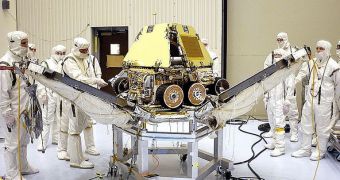The NASA Mars Exploration Rover (MER) Opportunity has just surpassed another record on the surface of the Red Planet, after it traveled for more than 50 times the original distances planned for the mission. At this point, the robot's odometer is well over 20 miles.
The rover exceeded the 20-mile mark during a 407-foot (124-meter) drive on July 17. In the mean time, it continued onwards relentlessly. On July 27, its odometer showed that the machine had exceeded 20.49 miles (33 kilometers) on the surface of Mars.
When Opportunity was deployed on January 25, 2004, just three weeks after Spirit arrived at the Red Planet too, it was scheduled to last for only three months, and to drive for only 600 meters or so.
However, both spacecraft proved to be extremely resilient, and manged to endure for about seven years. Contact with Spirit was lost in 2010 and never recovered, but that rover had it much worse than Opportunity. It had to survive Martian winters, whereas its twin is largely unaffected.
This also explains why Spirit drove for only 4-5 miles, whereas its counterpart more than 20. Regardless, both managed to collect vast volumes of date, which seem to corroborate the theory that liquid water once existed on the surface of Mars.
Having proven this, Opportunity was set on a course for the Endeavour crater, a massive hole in the surface of the planet that reveals much about its geological history. Experts at the NASA Jet Propulsion Laboratory (JPL) barely dared to dream that they would reach this destination.
They have been driving towards it since mid-2008, and slowly they watched its rim get ever closer on the horizon. At this time, the rover is about 500 meters (0.3 miles) from the crater, and is expected to arrive at its rally point in less than a week.
“The numbers aren't really as important as the fact that driving so much farther than expected during this mission has put a series of exciting destinations within Opportunity's reach,” a statement from JPL rover mission manager Alfonso Herrera says.
One of the things that mostly attracts scientists towards Endeavour crater is the fact that it contains clay deposits, which are proof that water once flowed at this location. The deposits were identified using the NASA Mars Reconnaissance Orbiter (MRO) and the Mars Odyssey spacecraft, Space reports.
The rover would have made it to its destination sooner, had its right front wheel not been damaged early on in the mission.
“Opportunity has an arthritic shoulder joint on her robotic arm and is a little lame in the right front wheel, but she is otherwise doing remarkably well after seven years on Mars – more like 70 in 'rover years',” JPL MER engineering team chief Bill Nelson says.
“The elevated right front wheel current is a concern, but a combination of heating and backwards driving has kept it in check over the past 2,000-plus sols [Martian days],” he concludes.

 14 DAY TRIAL //
14 DAY TRIAL //